Don’t wait. Digitalize now! Microsoft Inspire is the major annual highlight by and for Microsoft and its partners, covering all aspects of the change of fiscal years at the company. This year’s conference was held from July 19 through 21. Once again, the format was virtual. In addition, the national affiliates in countries such as Germany and France held local and/or hybrid events. The Campana & Schott team participated in the various events this year, as in years past, and offers a summary of their impressions.
Achieving more with less
It’s time to do more than just talk about the digital transformation. Companies need to deliver digitalization here and now. Every company is, or soon will be, also a software company in order to ultimately achieve more with less, said Satya Nadella (Chairman & CEO, Microsoft Corporation) right at the start of his keynote address. As an example, Nadella pointed to a German automaker that already has more than 10% of its staff working in the field of software, on applications such as the vehicle operating system.
Microsoft’s aim here is not just to deliver best-in-class products, but also to ensure that Microsoft Cloud is the best platform over the entire tech stack.
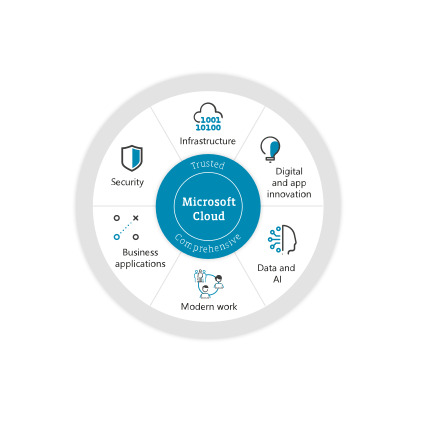
The Microsoft Cloud with a claim to deliver the best platform across the tech stack.
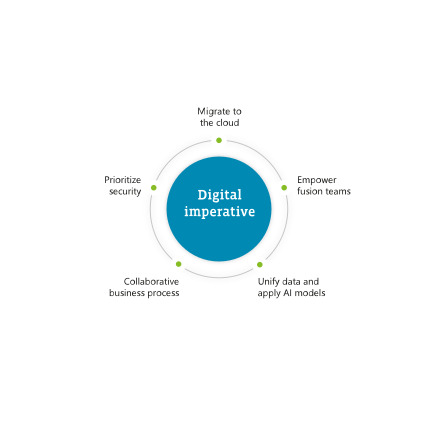
In cooperation with our partner, Microsoft, we can offer selected companies free workshops to help them get acquainted with these topics. For more on this, please see the individual areas. Contact us!
The pages that follow sum up our assessments and findings on individual subject areas. Read more about:
Migrating to the cloud
The starting point is the infrastructure, or more precisely, migrating it to the cloud. Cloud-native is the ideal, but it is difficult or time-consuming for established companies to achieve. Microsoft is the only provider to offer a solution for hybrid cloud scenarios in response (linking on-premises or edge services with the cloud), along with multi-cloud scenarios (management of other producers’ clouds).
This establishes links between IT (information technology) and OT (operational technology) and makes it possible to shift some of the spending from capex (capital expenditure) to opex (operational expenditure) while also giving organizations completely new options for scaling.
Boosting operational efficiency, faster value creation, and cost reduction are all big opportunities for IT.
We share the belief that companies will miss out on current and future megatrends like hybrid work and sustainability unless they consistently invest in the cloud. But it’s not just about trends and opportunities. It’s also about overcoming crises. Here as well, systematic investment in cloud technologies pays off in the form of increased resilience and robustness and improved ability to respond.
It’s time to dispense with the image of IT as a cost center and instead embrace it as a business partner and critical success factor for a company’s success.
Infrastructure Assessment & Infrastructure Migration Workshop: We will show you potential and approaches, assess your current IT infrastructure, and work with you to craft a roadmap.
No-code, low-code, full-code: Anyone can develop!
According to an IDC study, more than 500 million new applications will be created in the next five years – that’s more than in the past 40 years put together. With so much activity taking place, demand for software developers is robust across all industries, and it’s already clear that solutions beyond “hire more software developers” will be needed.
Using no-code and low-code technologies is a major success factor here in allowing citizen developers – employees of specific departments – to implement applications independently, but still within the frameworks, and subject to the technical and organizational specifications, established by IT. Gartner estimates that 70% of new applications created between now and 2025 will be implemented on the basis of these technologies.
The Power Platform from Microsoft is geared toward this market segment. This technology is already used by more than 20 million employees. One key success factor in digital capability has proven to be the center of excellence approach (XX link to CS service page; please ask Marc Schäfer/Ingo Meironke if it is live yet).
Full-code and/or professional developers will continue to be responsible (out of necessity) for modernizing existing applications and crafting complex new ones, at least in part. Microsoft offers a wide range of Azure components as technologies to meet these needs. The key here is that all these different products fit together into a single integrated tool set, so no-code, low-code, and full-code developments can benefit from each other and work together without friction.
Toolset
Both the modernization of existing applications and the creation of new, complex applications will (have to) be carried out, at least in part, by full-code or professional developers in the future. Microsoft offers corresponding technologies in the form of various Azure components. The highlight is that the various products combine to form an integrated toolset so that no-code, low-code and full-code developments can benefit from each other and work together without friction.
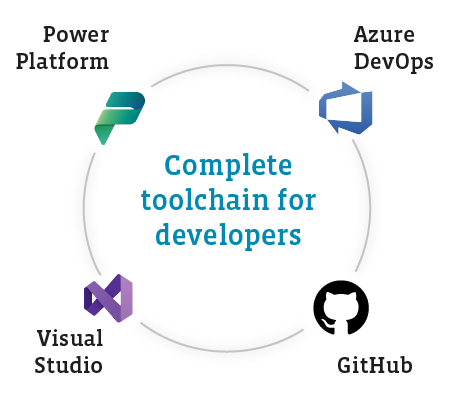
Integrated toolset for no-code, low-code, and full-code developers.
Azure Data Modernization Workshop: We will show you commonly used approaches and the potential of modern technology, such as artificial intelligence (AI), analytics, and cloud-native apps.
Center of Excellence (COE) Workshop: We will show you what kind of good governance of the Power Platform is needed and how you can get buy-in from your management and employees in specialized units for citizen development and give them the skills they need to succeed in this arena.
Combining data and using AI models
These days, many companies are investing a lot of time in data engineering and data integration with a wide range of tools for databases and data warehouses (advanced ones) – in the cloud and on-premise, involving analytics and AI use cases. Before data-driven innovations can be harnessed, a lot of investment in costly preparatory work is needed. Microsoft’s response to this widespread challenge is the Microsoft Intelligent Data Platform, a solution just launched this year. Microsoft promises its customers what it calls the most complete, best-integrated product portfolio for data-driven and AI-driven use cases and architectures. The products in this portfolio are diverse and integrated, and they typically offer multiple solutions per subject area, not just one. Important products include Azure SQL, Azure Synapse Analytics, Power BI, and Microsoft Purview.
Some of Microsoft’s key arguments for using these products are aimed at cost leadership compared to competitors, the highest possible benchmark results in the area of performance, and an end-to-end approach to security. In line with these considerations, 70% of Fortune 1000 companies have already decided to use Microsoft Data Platform products.
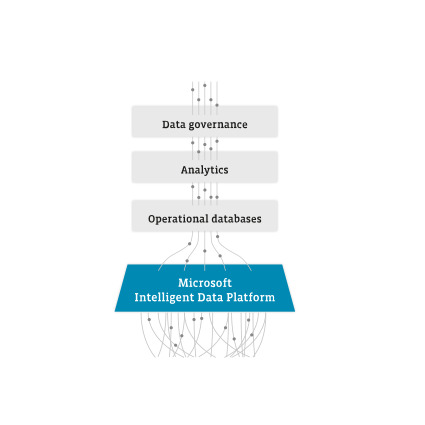
Data Strategy Assessment Workshop: We will show you what use cases are possible using your data and tools from the Microsoft Intelligent Data Platform. The focus is on both the achievable benefits and the suitable target architecture based on Microsoft Azure.
Dashboard In-A-Day Workshop: We will show you how to create dashboards on the basis of Power BI and provide them to your teams.
Collaborative business processes
Microsoft has concluded that there has been a sea change in the past year as organizations re-learn that their employees are crucial to their success. Uncertainty has also increased dramatically on the markets, pushing organizations to adopt resilient positions to counter potential market shifts. This means the new three Ps – people, places, and processes – are critical to the emerging new normal, in which hybrid work will be a major factor.
According to Microsoft, reducing the digital workplace to information workers is no longer adequate. Instead, frontline workers and temporary workers, whether they are project partners or simply temps on assignment, must also be included in companies’ considerations.
Microsoft 365 is the key technology platform for this, and in Windows 365, Microsoft offers a virtual cloud PC to meet these needs. It is an interesting alternative, especially when it comes to temporary workers.
Microsoft 365 Digital Workforce Workshop & Modern Workplace Assessment: We will show you what is state-of-the-art in the digital workplace segment and what an IT development plan for this might look like and work with you to develop a roadmap to get you there.
Employee Experience and Microsoft Viva
The human factor as the crucial aspect: the driving force at any organization is its people. In the Microsoft Viva employee experience platform, Microsoft has created a platform with Microsoft Teams as the user interface that offers employees all the information and tools they need to perform their best and get the best from their teams. Microsoft will be focusing on four central realms of employee experience:
- Informing and including all employees within an organization
- Personal learning and growth, integrated into day-to-day work
- Boosting organizational performance through purpose and vertical strategy integration
- Supporting healthy division of labor and work-related behavior that promotes health
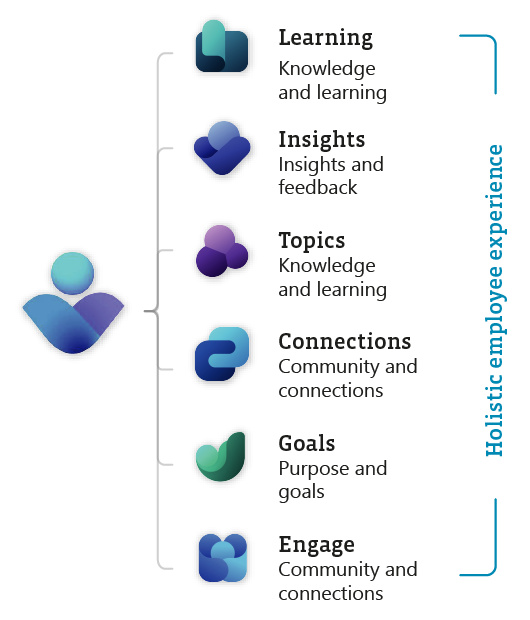
Microsoft has stated that the Microsoft Viva platform is already being used by over 1,000 organizations worldwide, and Microsoft is innovating at a rapid pace in this segment. Four modules are already available: Connections, Topics, Learning, and Insights. Two new ones, Goals and Engage, were announced at Inspire, along with Viva Sales, the first role-specific module.

We are proud to have been named by Microsoft during the Microsoft Inspire event as one of the top four out of a Microsoft ecosystem encompassing more than 400,000 partners worldwide in the area of employee experience. A big thank you goes out to our customers for making this possible.
We’re happy to show you potential and current developments. Contact us or sign up for one of our roundtable discussions. We will be holding these meeting in various cities around Germany and in France starting in October. Further details will be published shortly.
Frontline workers
Microsoft stresses that frontline workers are the backbone of many industries. They make up more than 80% of staff worldwide, accounting for a ratio of 6:1 in retail and 3:1 in manufacturing. Even so, they have largely been left behind in the big push to adopt new and digital technologies amid the pandemic. That is even more astonishing given that these employees are highly optimistic about tech and there is an acute shortage of skilled workers (such as airport and security staff, warehouse specialists, and drivers).
Microsoft outlines the potential of integrating frontline workers into the digital workplace across four fields:
- Boosting productivity and loyalty through interconnected and engaged staff.
- Improving collaboration among frontline workers and between frontline and information workers.
- Boosting operational efficiency through process digitalization.
- Data security and data protection based on a platform provided by the IT team.
Enable Frontline Workshop: We will show you scenarios you can use to create added value in the short term and what the relevant organizational and technical points of a potential roadmap are like.
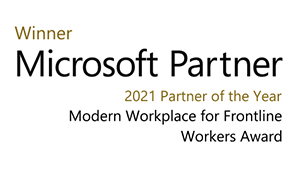
Last year, Campana & Schott was named Partner of the Year by Microsoft in the frontline worker category. Various customer references attest to our expertise and successes.
Microsoft Teams
Worldwide, more than 270 million employees already actively use Microsoft Teams, and Microsoft is positioning Microsoft Teams as the central user interface for all employees. According to statements made by Microsoft during the event, the company is hard at work on integrating everything that is relevant to employees into the flow of work intuitively and by means of AI.
However, it has become apparent that many organizations are not yet utilizing Microsoft Teams to its fullest potential. Microsoft points to three key areas here:
Microsoft Teams Phone
Just 30% of M365 customers are already using Microsoft Teams Phone. Pros:
- For the end user: state-of-the-art functionality, simplified communication, and collaboration via a central app, combined with a flexible mobile-first experience on devices of an individual’s personal choice.
- For IT: lower costs thanks to vendor consolidation and savings on licenses, reduced complexity in both deployment and IT administration.
Teams Phone Workshop: We will present the latest features and show you how you can move from your current phone system to an integrated solution based on Microsoft Teams.
Microsoft Teams Rooms
Overcoming geographic and time differences is a key element of making hybrid work work. Studies have shown that 90% of organizations do not yet have the technical equipment to do this. For example, just eight percent of meeting rooms around the world have video capability.
In Microsoft Teams Rooms, Microsoft offers the technological platform to realize the vision of an inclusive, hybrid workplace. End users benefit from simple and quick meeting starts, high interaction and attention during meetings, and a strong team culture – even across time and geographic boundaries. With the Microsoft platform approach, IT teams can easily ensure data protection and security via hardware, software, cloud, and network while also tapping into potential for cost cutting through standardization.
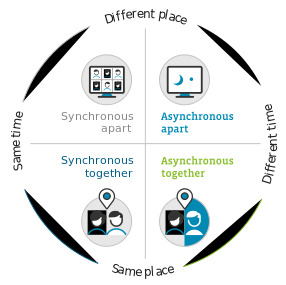
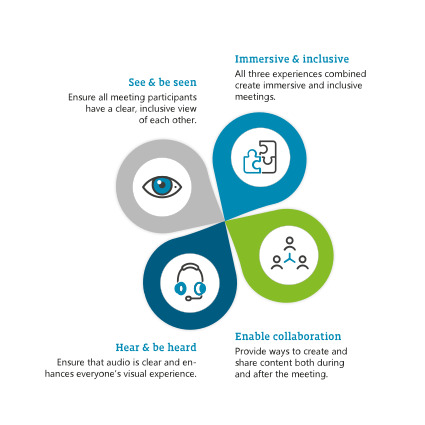
Teams Rooms Workshop: We will present the latest features, advise you on hardware, and show you how to go from your current conference system to an integrated solution based on Microsoft Teams.
Collaborative Apps
Day-to-day work will continue to be shaped by not just collaboration, but also operational processes and relevant line-of-business applications. Combining data, processes, and collaboration makes it possible to realize productivity gains and link cooperation among information workers and frontline workers. But many organizations are still in the early stages of combining structured and unstructured processes. Microsoft calls these kinds of integrated applications collaborative apps. They can then be used as a user interface within Microsoft Teams. These kinds of applications are surging in volume, with their number having grown by a factor of ten between 2020 and 2022. More than 80,000 line-of-business apps have already been integrated into Teams by organizations.
Collaborative Apps Workshop: We will show you how you can integrate existing applications into Teams and provide new applications integrated into Teams, based on the Power Platform or Azure, depending on the scenario.
Prioritizing security
Cybercrime is all around us, and according to recent studies, the harm it causes is expected to rise to 10.5 billion U.S. dollars between now and 2025. That’s why security remains a top priority for Microsoft. The company is forging ahead with the zero-trust strategy at top speed, pursuing a holistic approach that encompasses both traditional organizational IT and OT (operational technology), along with the IoT (Internet of Things). Microsoft is also in a class of its own as a platform provider in the area of security, combining products for identity and access management such as Microsoft Entra, for compliance and privacy such as Microsoft Purview and Microsoft Priva, and for security such as Microsoft Sentinel and Microsoft Defender into a single platform.
But alongside the technology itself, Microsoft stresses that people are a key factor when it comes to security. Still, organizations do not yet have cybersecurity awareness on their agenda, or they do not do so to a sufficient degree.
Cloud Security Assessment: We will work with you to analyze your organization’s security situation, assess vulnerabilities and identity and conformity risks, and discuss concrete recommendations with you. The Microsoft zero-trust framework forms the basis for this.




